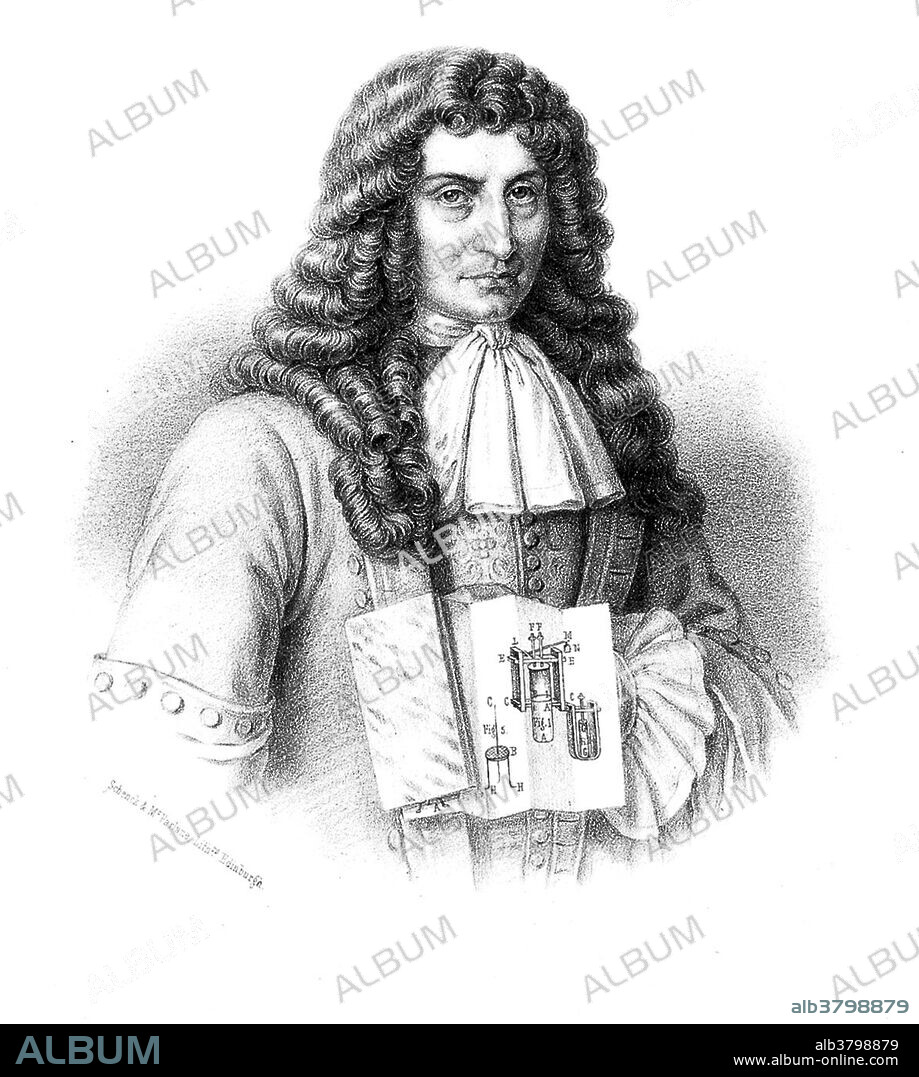alb3798879
Denis Papin With Steam Engine Diagram, 1689

|
Add to another lightbox |
|
Add to another lightbox |



Buy this image.
Select the use:

Title:
Denis Papin With Steam Engine Diagram, 1689
Caption:
Papin holding a diagram of a steam engine, lithograph, 1689. Denis Papin (August 22, 1647 - 1712) was a French physicist, mathematician and inventor. He worked with Robert Boyle from 1676-79, publishing an account of his work in Continuation of New Experiments (1680). During this period, Papin invented the steam digester, a type of pressure cooker with a safety valve. While in Marburg in 1690, having observed the mechanical power of atmospheric pressure on his digester, he built a model of a piston steam engine. In 1704, he constructed a ship powered by his steam engine, mechanically linked to paddles. This made him the first to construct a steam-powered boat (or vehicle of any kind). In 1705 he developed a second steam engine with the help of Gottfried Leibniz, based on an invention by Thomas Savery, but this used steam pressure rather than atmospheric pressure. He returned to London where several of his papers were put before the Royal Society between 1707-12 without acknowledging or paying him. The last surviving evidence of his whereabouts came in a letter he wrote dated January 23, 1712. At the time he was destitute, and it is believed he died that year and was buried in an unmarked pauper's pit.
Personalities:
Credit:
Album / Science Source / Wellcome Images
Releases:
Model: No - Property: No
Rights questions?
Rights questions?
Image size:
2953 x 3292 px | 27.8 MB
Print size:
25.0 x 27.9 cm | 9.8 x 11.0 in (300 dpi)
Keywords:
1647 • 1712 • 17TH CENTURY • 18TH CENTURY • 18TH CENTURY, THE • 18TH • ART • ARTWORK • BW • CELEBRITIES • CELEBRITY • DENIS PAPIN • DIAGRAM • DRAWING • EUROPEA • EUROPEAN • EUROPEANS • FAMOUS PEOPLE • FAMOUS • FIGURE • FRENCH • HISTORIC • HISTORICAL • HISTORY • ILLUSTRATION • ILLUSTRATIONS • IMPORTANT • INVENTOR (MALE) • INVENTOR • MALE • MAN • MATHEMATICAL • MATHEMATICIAN • MEN • NOTABLE • PAPIN • PEOPLE • PERSON • PERSONALITIES • PERSONALITY • PHYSICIST • PISTON STEAM ENGINE • PISTON • PORTRAIT • POTRAIT • PRESSURE COOKER • SCIENCE • STEAM DIGESTER • STEAM DRIVEN • STEAM ENGINE • STEAM POWERED • STEAM PRESSURE • STEAM TURBINE • STEAM-DRIVEN • STEAM-ENGINE • STEAM-POWERED BOAT • STEAM-POWERED • STEAM-PRESSURE • STEAMENGINE • WELL-KNOWN • XVIII CENTURY
 Pinterest
Pinterest Twitter
Twitter Facebook
Facebook Copy link
Copy link Email
Email
